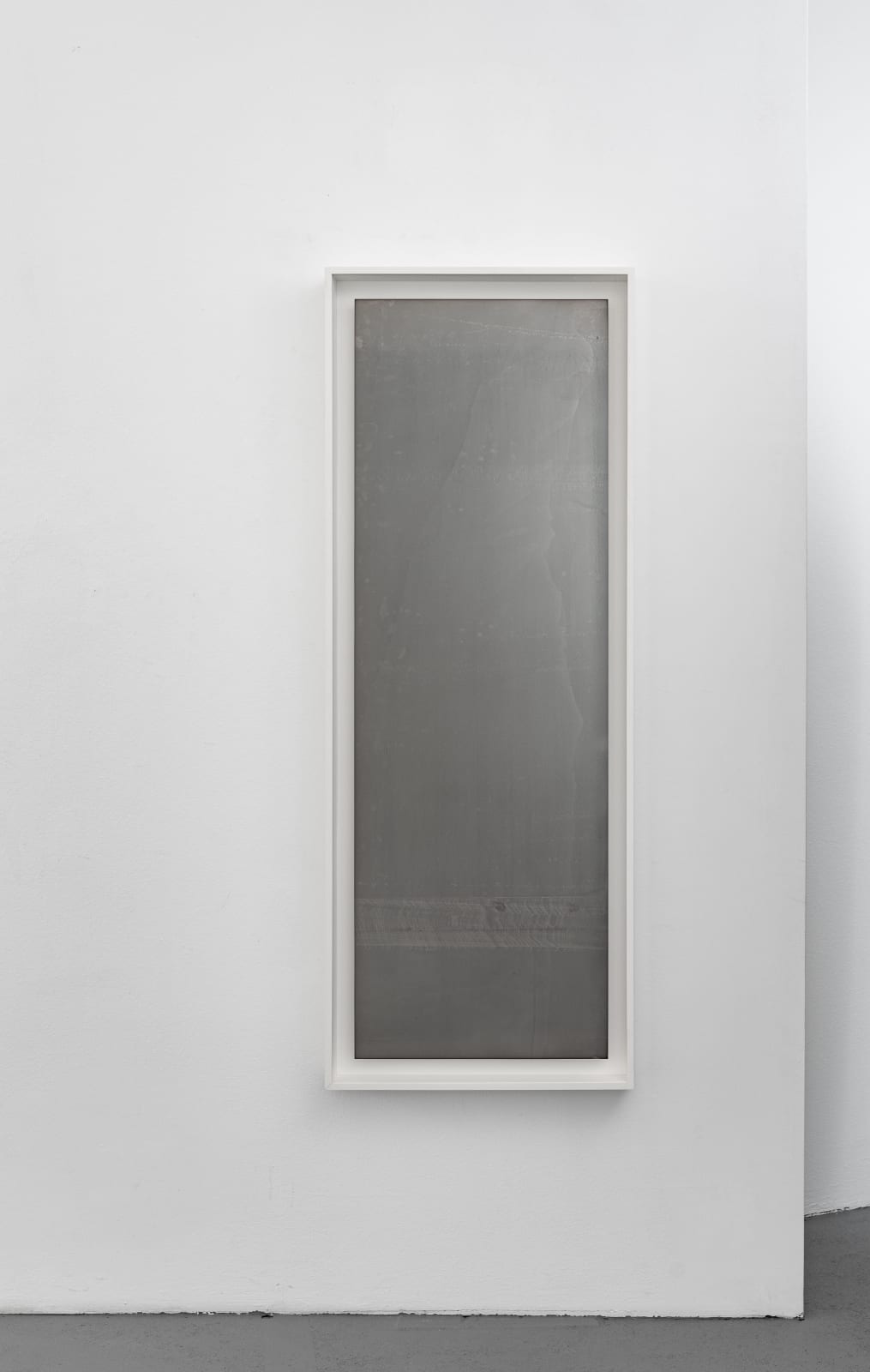Liz Deschenes
1898 - 1928, 2019
Silver toned photogram mounted on aluminum
152.4 x 50.8 cm
60 x 20 inches
60 x 20 inches
Copyright of the artist
Photo: Dirk Tacke
Weitere Abbildungen
'1898 - 1928' (2019) ist ein hochformatiges Fotogramm, das auf eine Aluminiumplatte aufgezogen gleichzeitig als Fotografie und bildhafter Prozess zu begreifen ist. Liz Deschenes erkundet das materielle Potenzial der Fotografie...
"1898 - 1928" (2019) ist ein hochformatiges Fotogramm, das auf eine Aluminiumplatte aufgezogen gleichzeitig als Fotografie und bildhafter Prozess zu begreifen ist. Liz Deschenes erkundet das materielle Potenzial der Fotografie unter Verwendung der elementaren Aspekte des Mediums: Fotopapier, Licht und Chemikalien. Deschenes zeitintensiver Arbeitsprozess beginnt damit, dass sie lichtempfindliches Papier dem Umgebungslicht der Nacht aussetzt und es anschließend mit Silbertoner wäscht und fixiert. Die so entstandenen Fotogramme tragen feine, abstrakte Spuren ihres Entstehungsprozesses und beziehen durch ihre spiegelnden Oberflächen sowohl die Betrachter/innnen, als auch den räumlichen Kontext ihrer Präsentation mit ein. Da das Material zu weiterer Oxidation neigt, entwickeln sich die Arbeiten im Laufe der Zeit langsam weiter. Der Ausstellungsraum wird so zur Kamera, der je nach Lichteinfall die Veränderung der Oberfläche mitbestimmt. So absorbiert "1898 - 1928" einerseits Licht und macht die materielle Entwicklung der Fotografie erfahrbar. Deschenes versteht ihre Fotogramme aber ebenso als eine Erfahrung von Raum und Zeit, die sich in ihnen einschreibt. Ihre Fotogramme sind im Gegensatz zur traditionellen Fotografie nicht mehr nur eine Momentaufnahme, sondern nehmen die Einflüsse ihrer Umgebung fortwährend in sich auf.
"1898 - 1928" (2019) is a portrait-format photogram, mounted on an aluminum plate, which can simultaneously be understood as a photograph as well as a pictorial process. Liz Deschenes explores the material potential of photography by utilizing the elemental aspects of the medium: photo paper, light and chemicals. Deschene's time-consuming work process begins with exposing light-sensitive paper to the ambient light of the nighttime and subsequently washing and fixing it with silver toner. The resulting photograms bear fine, abstract traces of their creation process and, through their reflective surfaces, include both the viewer and the spatial context of their presentation. As the material continues to oxidize, the work slowly evolves over time. The exhibition space thus becomes a camera itself, which, depending on the incidence of light, co-determines the surface changes. Thus, "1898 - 1928" absorbs light and at the same time makes the material development of photography tangible. Deschenes also understands their photograms as an experience and inscription of space and time. In contrast to traditional photography, her photograms are no longer just a snapshot, but continuously absorb the influences of their surroundings.
"1898 - 1928" (2019) is a portrait-format photogram, mounted on an aluminum plate, which can simultaneously be understood as a photograph as well as a pictorial process. Liz Deschenes explores the material potential of photography by utilizing the elemental aspects of the medium: photo paper, light and chemicals. Deschene's time-consuming work process begins with exposing light-sensitive paper to the ambient light of the nighttime and subsequently washing and fixing it with silver toner. The resulting photograms bear fine, abstract traces of their creation process and, through their reflective surfaces, include both the viewer and the spatial context of their presentation. As the material continues to oxidize, the work slowly evolves over time. The exhibition space thus becomes a camera itself, which, depending on the incidence of light, co-determines the surface changes. Thus, "1898 - 1928" absorbs light and at the same time makes the material development of photography tangible. Deschenes also understands their photograms as an experience and inscription of space and time. In contrast to traditional photography, her photograms are no longer just a snapshot, but continuously absorb the influences of their surroundings.
exhibitions
Regroup Show, Miguel Abreu Gallery, New York, NY, January 23 - May 15, 2021 (88 Eldridge)1
von
5









